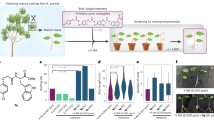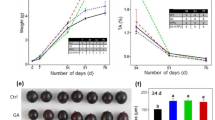Abstract
WE have been engaged in work on the effects of some kinetin analogues on various tree species and have found that they have somewhat different biological activity1,2. Because of the comparatively low solubility of 6-furfurylamino- and 6-benzylaminopurine in water, which complicates the application of these compounds, our interest was directed primarily to the preparation of kinetin derivatives with higher solubility in water. The solubility of kinins can considerably influence their transport and therefore also their practical application. After application of 6-benzylaminopurine-8-14C into the petioles of leaves of one-year-old apple shoots, the applied kinin was found by autoradiography about 10 cm in the basipetal direction from the point of application whereas kinin transport in the apical direction was negligible1,2. The most soluble compounds of this type synthesized by us up to now are N-(6-purinyl)-β-phenylalanine and N-(6-purinyl)-α-phenylglycine and the 6-benzylamino-9-glucosylpurine already described3,4. The first of these had no biological activity. 6-Benzylamino-9-glucosylpurine was about as active as 6-benzylaminopurine, whereas the biological activity of N-(6-purinyl)-α-phenylglycine depended on the type of application. The activity of N-(6-purinyl-α-phenylglycine applied to the bark and bast is more active in stimulating the buds of apple trees from the winter vegetative rest than is 6-benzylaminopurine itself, or 6-benzylaminoglucosylpurine5. Fig. 1, where N-(6-purinyl)-α-phenylglycine was applied to every second bud, shows that leaves of considerable size shot from the stimulated buds within 20 days, whereas no change was observed in the unstimulated control buds.
This is a preview of subscription content, access via your institution
Access options
Subscribe to this journal
Receive 51 print issues and online access
$199.00 per year
only $3.90 per issue
Buy this article
- Purchase on Springer Link
- Instant access to full article PDF
Prices may be subject to local taxes which are calculated during checkout
Similar content being viewed by others
References
Chvojka, L., Vereš, K., and Kozel, J., Biol. Plant., Praha, 3, 140 (1961).
Chvojka, L., and Vereš, K., Proc. V. Intern. Biochem. Congr., Moscow (1961).
Brown, G. B., and Weliky, V. S., J. Biol. Chem., 204, 1019 (1953).
Blackburn, G. M., and Johnson, A. W., J. Chem. Soc., 4347 (1960).
Chvojka, L., Kračmar, P., Beneš, J., and Belea, A., Biológia, 8, 579 (1963).
Author information
Authors and Affiliations
Rights and permissions
About this article
Cite this article
BENEŠ, J., VEREŠ, K., CHVOJKA, L. et al. New Types of Kinins and their Action on Fruit Tree Species. Nature 206, 830–831 (1965). https://doi.org/10.1038/206830b0
Issue Date:
DOI: https://doi.org/10.1038/206830b0
This article is cited by
-
Regulators of cell division in plant tissues XXIX. The activities of cytokinin glucosides and alanine conjugates in cytokinin bioassays
Journal of Plant Growth Regulation (1983)
-
Effect of N6benzyladenine on vegetative growth and tuber production in potato
American Potato Journal (1972)
-
Rapid Bioassay for Phytokinins based on Transpiration of Excised Oat Leaves
Nature (1967)
Comments
By submitting a comment you agree to abide by our Terms and Community Guidelines. If you find something abusive or that does not comply with our terms or guidelines please flag it as inappropriate.



